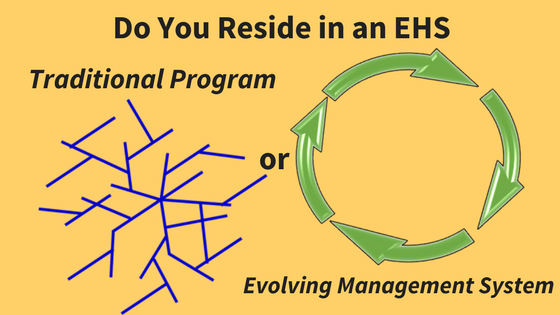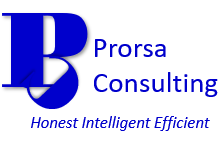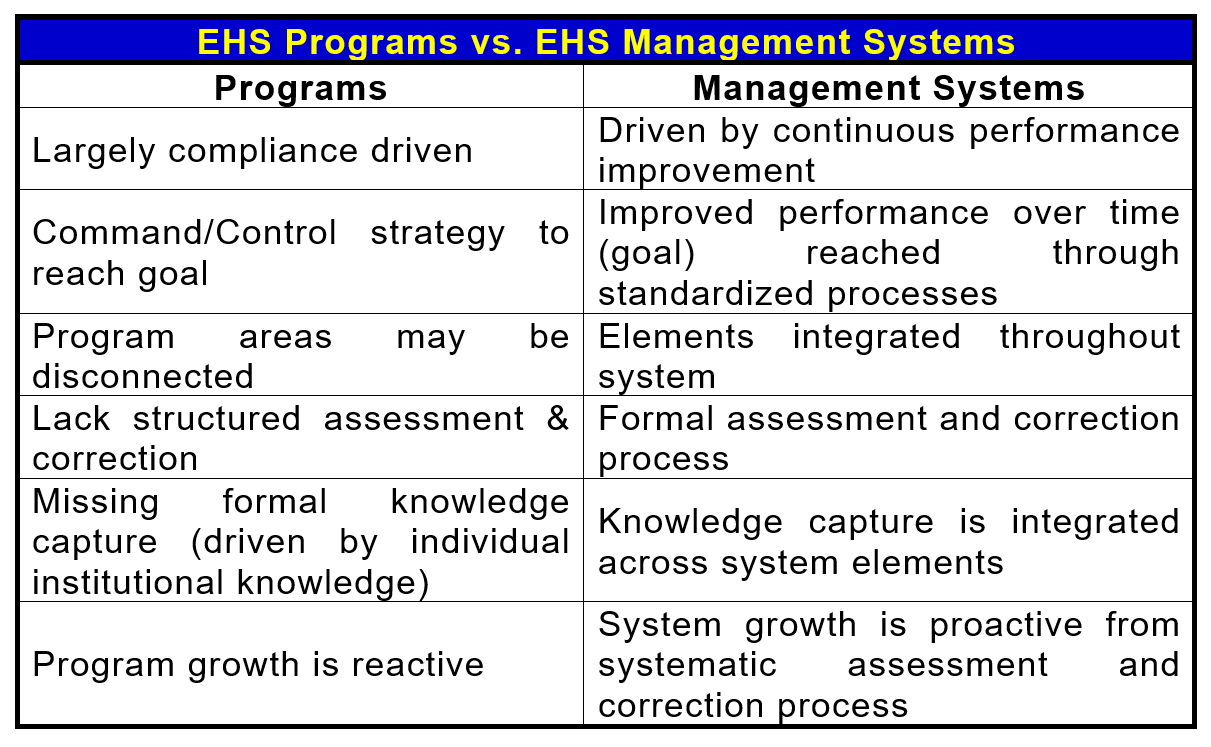Do You Reside in an EHS Traditional Program or Evolving Management System?
By : Admin -

Regardless of the industry or company, a mechanism usually exists for managing its environmental, health, and safety (EHS) compliance and risk. These mechanisms vary in maturity, scope, and complexity. Some take the form of programs while others follow the management system approach. Does your organization own an EHS program or an EHS management system? Let’s delve into program and management system fundamentals to find the answer.
Aren’t programs and management systems basically the same?
The short answer is not necessarily? An organization can call something a program when it’s actually a management system and vice versa. The old saying of “if it walks like a duck and talks like a duck . . .” does not hold true here. Programs and Management Systems often share a lot of the same components. However, the philosophy behind each differs, meaning the results from each can look vastly different over time.
Programs, Raise Your Hands!
In the EHS world, typically a program encompasses the procedures or compliance plans implemented to cover given program areas. You may perform periodic audits and even report performance statistics for the program. Nevertheless, the primary program often exists in a command/control type structure (i.e. regulation says we need this written plan . . . we develop and follow it).
Programs have a well-earned place in EHS management. They can help sites stay in regulatory compliance and reach certain business goals. Programs may lack the same level of complexity as management systems, which can make implementation easier. Programs are the traditional standard of EHS management within organizations.
However, I tend to think of programs as a web of straight lines. Some of the lines connect; others do not. As such, once you pass a point on any given line, you don’t usually go back. Programs generally don’t prescribe evaluation and future correction. Growth happens in a somewhat reactive manner due to changes in regulations or found instances of noncompliance. Individual institutional knowledge drives many programs. As such, programs can suffer as individuals change roles or leave.
Management Systems, Identify Yourselves!
So, how does a management system differ? Management systems set up a process companies utilize to positively affect EHS performance. Management systems leap beyond merely compliance and/or short-term concerns, as the goal is better performance over time. In addition, they facilitate standardization, cohesiveness, knowledge capture, and continuous improvement when implemented correctly. EHS management systems integrate with other business processes into an overall business management system.
Nevertheless, management systems intensively use resources during initial implementation. Moreover, an organization’s culture must be robust enough to support the management system process to ensure success. Additionally, companies can fall into the trap of unnecessary excessive documentation (i.e. writing procedures for how to buckle a seat belt, tie safety boots, read a thermometer, etc.) with management systems when a balance is not adequately defined and enforced.
Plan-Do-Check-Act (PDCA) serves as a leading model for management systems. The structured evaluation (Check) and correction (Act) sets management systems apart from programs. I think of management systems as circles with no end and no beginning. As the circle is traveled, you pass by the same points time and time again. This gives the opportunity to assess and improve from experience.
Management systems can take many shapes and forms. They can be based on consensus standards or fitted specifically to an organization’s needs. We’ll cover management system specifics in more detail during a future post.
So . . . Does your organization own a program or a management system?
Hopefully, you can make an educated guess to answer this question by now. Organizations may even own a hybrid of the two mechanisms, leaning largely to the program approach with pieces of a management system or vice versa. Just to review, the table below summarizes the key elements of programs versus management systems.
Programs and management systems both have their places with regard to EHS. The decision of program vs. management system ultimately lies with the organization’s leadership after carefully evaluation of needs and resources. Yet, there is always room for improvement regardless of the mechanism used to manage EHS.
Want to explore more on EHS management systems? Check out the following links to information for some popular EHS management system standards/frameworks:
Related EHS Management Systems Content
The Power of Corporate Social Responsibility: Why It’s Essential for Businesses Today
Your feedback on this blog’s content is always encouraged. If you found this information useful, be sure to like and/or share below! You can also give your feedback via our Contact Us page.
You can follow Prorsa Consulting on LinkedIn, Pinterest, and Twitter for regular updates to our content.

